How to Bathe a Cockatiel? 3 Suitable Bathing Options
Bathing plays a crucial role in maintaining the health and happiness of your beloved cockatiel. Not only does it contribute to their overall grooming routine, but it also helps them maintain the condition of their feathers.
So how to bathe a cockatiel? There are some factors you need to consider while bathing your cockatiel. Ensure you bathe them 2 or 3 times a week. Choose the best suitable bathing option, such as spray baths, water dish baths, or shower-baths. And make sure the water temperature is between 18° Celsius to 23° Celsius.
This guide will delve into the various aspects of bathing your cockatiels. Thus, includes the appropriate frequency, suitable bathing options, bath temperature, and post-bathing care. Let’s get started!
Suitable Bathing Options for a Cockatiel
There are 3 suitable bathing options for your cockatiel. Let’s explore them.
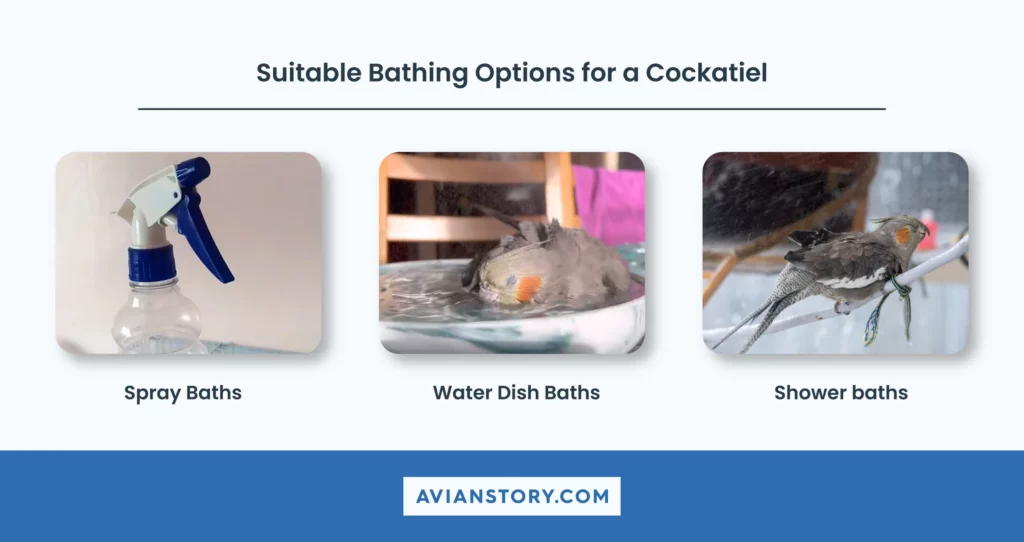
1. Spray baths:
These involve misting your cockatiel with water using a spray bottle. They are convenient and excellent for cockatiels hesitant to bathe in standing water.
2. Water dish baths:
Water dish baths provide a shallow water dish for your cockatiel to wade and splash around. This mimics their natural behavior in the wild. Your cockatiel can then enjoy splashing and playing in the water as they please.
3. Shower-baths:
You take your cockatiel into the shower with you. The gentle flow of water and humidity can be pretty enjoyable for them. But be mindful of the water pressure and avoid getting water directly in their face.
Preparing a Suitable Bath for Your Cockatiel Inside Its Cage
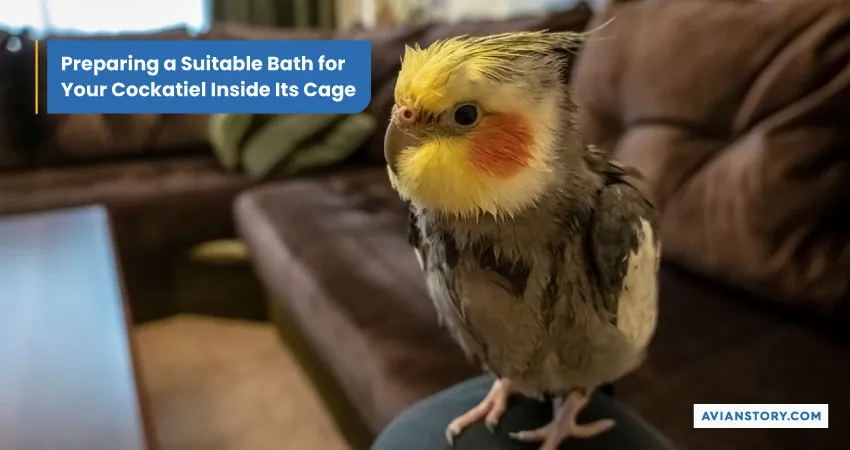
Creating a safe and comfortable bathing environment within your cockatiel’s cage is essential.
1. Start by selecting a suitable bathing dish or container shallow enough for your bird to access and exit quickly.
2. Place the bath at a convenient height within the cage and ensure it is stable to prevent accidents.
3. Next, line the bottom of the bath with clean pebbles or rocks to provide a stable surface and prevent splashing.
4. Fill the bath with warm water to a depth that allows your cockatiel to wade comfortably. The US Fish and Wildlife Service recommends not to add salt to the water.
5. To encourage your cockatiel to use the bath, you can place familiar toys or objects nearby to create a sense of security. Ensure the toys for the cockatiel are safe and contain no toxic materials.
6. Also, provide an escape route or perch near the bath to allow your bird to exit easily if they feel uncomfortable.
How to Use a Bath Spray for Your Cockatiel?
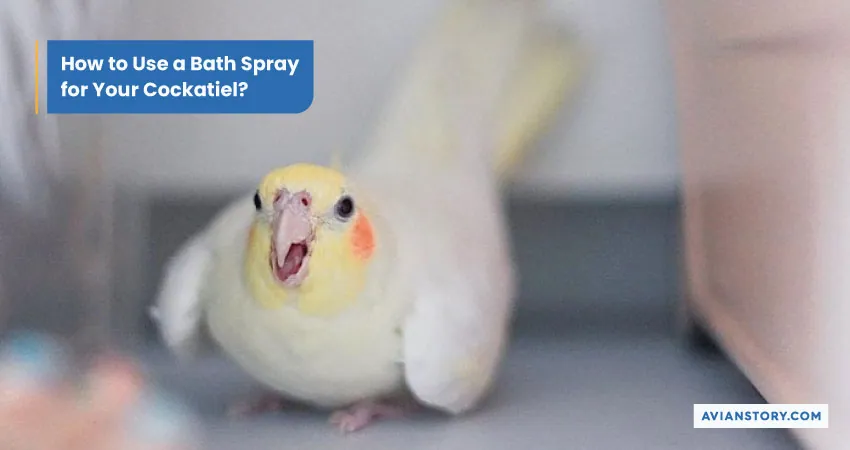
If you decide to go with bath sprays. Here is exactly how you should do them right:
1. Choose a suitable bath spray: Look for a specially formulated bird bath spray safe for cockatiels. Avoid using sprays that contain any harmful chemicals or fragrances.
2. Adjust the spray nozzle: Ensure that the spray nozzle is set to a fine mist. This will provide a gentle and even water distribution over your cockatiel’s feathers. A fine mist closely resembles the sensation of natural rain showers, which cockatiels usually enjoy.
3. Introduce the bath spray: Hold the bottle a few feet away from your cockatiel, aiming slightly above its head. This allows the mist to fall gently onto their feathers. Avoid spraying directly into their face or eyes to prevent discomfort.
4. Observe your cockatiel’s response: Some birds may start preening and shaking their feathers in response to the mist. Others may need some time to adjust to the new experience. Respect their comfort level and adjust the spraying technique accordingly.
5. Repeat as desired: Depending on your cockatiel’s preferences, you can offer bath spray sessions regularly, usually a few times a week. However, be mindful not over-bathing your cockatiel, as excessive moisture can lead to health issues or feather problems.
The Ideal Bath Temperature for a Cockatiel
Research conducted by Universidade Federal de Minas Gerais, Escola de Veterinária, found that the comfortable temperatures for Cockatiels are from 18 to 23.8 degrees Celsius (64.4 to 74.84 degrees Fahrenheit). Use a thermometer designed for avian care to ensure the water temperature is appropriate.
If you have none, you can test it with your own skin to ensure it is warm but not hot. Never use cold water, as it can cause your cockatiel to become chilled. Also, monitor the water temperature throughout the bath, as it may cool down over time.
What to Do if Your Cockatiel Doesn’t Like Baths?
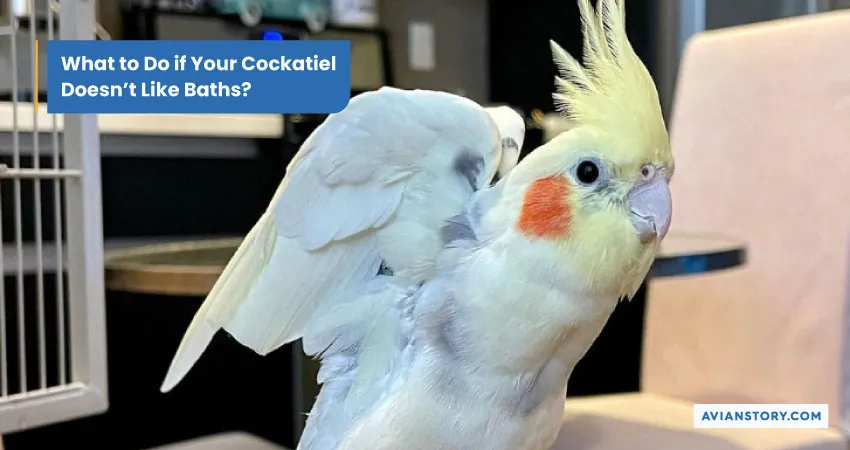
If your cockatiel is not a fan of bathing, here are a few brief tips to encourage them to enjoy bath time:
- Be patient: Some cockatiels may take time to warm up to bathing. Give them time to adjust and gradually introduce them to bathing routines.
- Try different methods: Experiment with different bathing options such as spray baths, water dish baths, or shower-baths. Observe their reactions and see which method they respond to more positively.
- Use visual cues: Place a small water dish or a favorite toy near their bathing area to attract curiosity and encourage exploration.
- Offer treats and positive reinforcement: Reward your cockatiel with their favorite treats. Praise them when they show interest or willingness to participate in bathing activities.
- Provide a buddy: Some cockatiels may feel more comfortable bathing when they see other birds enjoying the experience. Consider showing them videos of cockatiels bathing or allow them to observe other birds during their bathing routines.
You can also have another cockatiel for company. But keep in mind you must have a big cage size for cockatiel. This is if you house them in one place.
Introducing Your Baby Cockatiel to Bathing
When introducing your baby cockatiel to bathing, taking a gentle and gradual approach is essential. Here are a few tips to help you introduce your baby cockatiel to bathing:
Wait for the right time
- Before introducing your baby cockatiel to bathing, ensure they have settled into their new environment.
- They should have developed a sense of trust with you. This usually takes a few weeks after bringing them home.
- Also, they must be fully feathered and weaned.
Start with a shallow water dish
- Place the dish on the cage floor and let your baby cockatiel explore it at its own pace.
- They may initially be hesitant, so be patient and familiarize them with the water.
Monitor their comfort level
- Observe your baby cockatiel’s reactions to the water dish. Some may start by dipping their feet or beak in the water out of curiosity. Others may eventually venture in and start splashing around.
- Ensure that they feel safe and comfortable throughout the process.
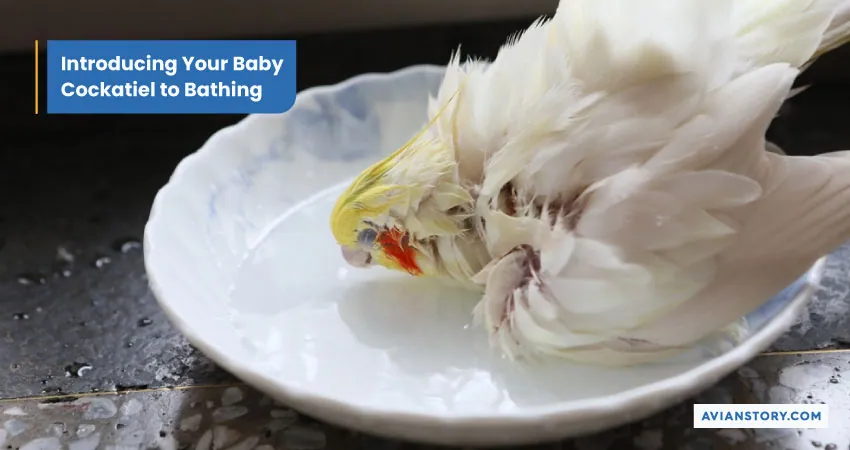
Gradually increase water depth
- As your baby cockatiel becomes more comfortable with the water dish, you can gradually increase the water depth.
- Add more water each time, ensuring it remains shallow enough for them to stand comfortably. This gradual increase will help them get accustomed to deeper water over time.
Introduce spray baths
- Once your baby cockatiel is comfortable with the water dish, you can start introducing spray baths.
- Use a gentle mist setting on a spray bottle and spray water above their head, allowing the mist to fall onto their feathers.
- Start with a few sprays and observe their response.
- Gradually increase the number of sprays as they become more accustomed to the sensation.
Patience and consistency
- Remember that each baby cockatiel is unique and may take varying amounts of time to become comfortable with bathing.
- Be patient, and consistent. Provide positive reinforcement through praise or treats to encourage their progress.
How Often Should You Bathe a Cockatiel?
The frequency of baths depends on various factors, such as the climate and your cockatiel’s preferences. Providing a bath 2-3 times a week is a good starting point.
However, closely observe your bird’s behavior and adjust the frequency accordingly. Some cockatiels may enjoy daily baths, while others prefer them less frequently.

Special Considerations for Bathing a Cockatiel During Molting
Molting is a natural process in which cockatiels shed and replace their feathers. During this period, they may be more sensitive and require special attention during bathing.
While some cockatiels enjoy baths to alleviate itchiness and discomfort, others may be more hesitant due to increased sensitivity.
So, adjust your bathing routine to accommodate their needs during molting. To minimize discomfort, opt for a softer spray mist or a shallow water dish. You must not pull or tug at loose feathers. This can cause pain or injury.
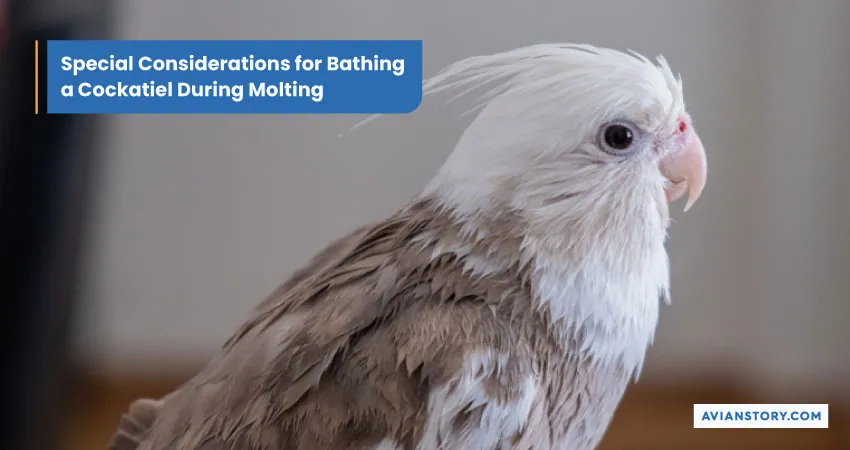
Post-Bathing Care for Your Cockatiel
Once your cockatiel has completed its bath, it’s essential to take appropriate steps for its comfort and safety.
1. Carefully remove the bathing dish or spray bottle from its cage to prevent accidental spills or slips.
2. Offer them a clean, warm towel or paper towels to rest on and gently pat their plumage to remove excess water.
3. Avoid using a hairdryer or heating device, as they can be dangerous and lead to overheating or burns. Instead, provide a warm, draft-free environment to allow your cockatiel’s feathers to air dry naturally.
4. Ensure the room is adequately heated, especially during cooler months, to prevent your bird from getting chilled.
5. While your cockatiel is drying off, monitor them closely and provide gentle reassurance. They may groom their feathers or preen during this time, which is a natural behavior. It helps to distribute oils and maintain feather quality.
6. If your pet is disabled, ensure you provide tools like sticks or other objects that it can use to preen itself.
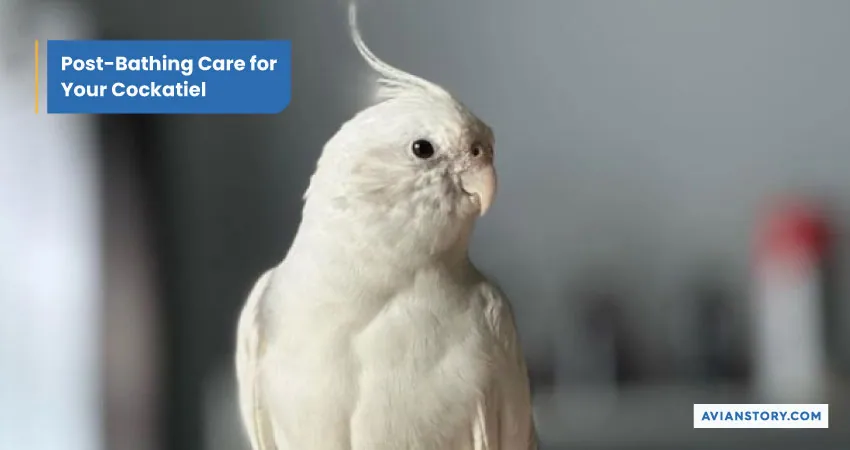
How to Dry a Cockatiel After a Bath?
Drying your cockatiel after a bath involves several steps to ensure the bird is comfortable, warm, and properly dried. Here’s a step-by-step guide:
Immediately After Bathing
- Remove Excess Water: Gently shake off excess water from the bird or let your cockatiel flap its wings to remove it naturally.
- Towel Dabbing: Use a soft, absorbent towel to lightly dab your cockatiel. Make sure not to rub, as this can damage their feathers.
Drying Methods
- Air Drying: Allow your bird to air dry in a warm, draft-free room. Place it on a perch or in a familiar area where it feels comfortable.
- Blow Drying: Some people prefer to use a hairdryer on a low heat setting. If you opt for this, hold the dryer at least a foot away from the bird to avoid overheating and frightening it. Always test the temperature with your hand first.
- Heat Lamp: This is another option, but it’s crucial to keep a safe distance between the lamp and your bird. Make sure to monitor your pet closely to prevent overheating.
Safety Measures
- Warm Room: Whichever method you choose, ensure the room is warm. Cockatiels are sensitive to drafts and temperature changes.
- Monitoring: Keep an eye on your bird throughout the drying process. If it looks distressed or uncomfortable, stop immediately.
- Check Feet and Under-Wings: These are areas where water might still linger. Make sure they’re dry to prevent any complications like fungal infections.
- Return to Cage: Once you’re certain your cockatiel is dry, return it to its cage. Ensure the cage itself is dry and clean.
- Offer a Treat: After the drying process, offer a little treat as a reward for good behavior.
Quick Tips
- Never use hot air from the blow dryer, as this can severely dehydrate and burn your bird.
- Be mindful of your bird’s behavior. If it appears stressed or scared, stop the drying process and try again later.
Remember, each cockatiel is different, so what works for one may not work for another. Always pay attention to how your bird is reacting to the drying process and adjust your technique as needed.
Dealing with Potential Bathing Issues or Concerns
Occasionally, cockatiels may experience bathing-related issues or concerns that require attention. Some common problems include excessive fear or resistance to baths, aversion to specific bathing methods, or difficulty drying off.
To address aversions to specific bathing methods, experiment with alternative options to find one your cockatiel is more comfortable with. For example, if they dislike spray baths, try providing a shallow water dish or vice versa.
Adapt to your bird’s preferences and comfort level while ensuring they receive regular bathing.
If your cockatiel consistently exhibits extreme fear or refuses to bathe, consult an avian veterinarian for guidance. They can assess your bird’s overall health and provide specific recommendations to address underlying issues.
Conclusion: Ensuring a Happy Bath Time for Your Cockatiel
Bathing is a crucial aspect of your cockatiel’s overall health and well-being. Knowing how to bathe a cockatiel correctly allows you to establish a positive and enjoyable bathing routine for your feathered friend. Remember to consider their preferences, monitor their comfort levels, and make adjustments as necessary.
With patience, understanding, and a gentle approach, bath time can become a cherished experience for both you and your beloved cockatiel. So, embrace the joys of bath time and watch as your cockatiel flourishes in its clean and happy feathers.

